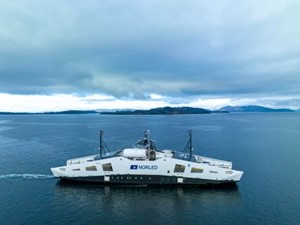News
MF Hydra sails on zero-emission liquid H2
MF Hydra is put into operation running on zero-emission H2, this is groundbreaking in several ways. In addition to the major technology development, a great deal of work has also been done to develop rules and regulations to enable Norwegian passenger ships to run on H2.
“The Norwegian Public Roads Administration (NPRA) is proud to contribute to making public procurement an instrument in developing and implementing new technology, and thus provide better facilities for road users,” said Anders Sæternes of NPRA Ferry Management.
“We have a tradition of using our role as a major purchaser to accelerate development towards the goals set for the transport sector. It is important for us to use our purchasing power for transition. Zero-emission vessels play an important part in this.”
While Norway persists as a leading global actor concerning the green shift within maritime transport—the Norwegian Public Roads Administration leads the nautical way towards a greener future—with our combined efforts in technological advancement and green policy development.
In the year 2000, the MF Glutra became the first car ferry to run off liquified natural gas (LNG). The use of LNG leads to reduced greenhouse gas emissions, as compared to traditional diesel operation. Eleven years ago, the NPRA issued a tender which resulted in the MF Ampere, the world's first electrical ferry with propeller drive.
“Therefore, by putting the world's first H2 ferry into operation, we now take yet another substantial leap towards the goal of zero emissions – in regard to ferries as well as the general maritime industry – both in Norway and internationally,” Sæternes said.
“Today will be a historic day, both for Norled and for Norway as a leading shipping nation. Today we are witnessing the world's first ship sailing on liquid H2,” said Heidi Wolden, CEO of Norled.
Since the turn of the year, Norled has been carrying out system tests at the quay in Hjelmeland. In recent weeks, they have been running sea trials and received the final approvals from the Norwegian Maritime Authority (NMA).
When the work on the MF Hydra started, both technology and regulations from classification societies and the Norwegian Maritime Authority were inadequate. Liquid H2 may be playing an important role in the green maritime transition. The pilot project in Hjelmeland is therefore very important for global shipping. The Maritime CleanTech business cluster works closely with the maritime industry and encourages the use of new zero-emission technology.
“MF Hydra confirms Norway's world-leading position in the development of new green maritime solutions. By putting the world's first H2 ferry into operation on a Norwegian ferry connection, we are once again showing how purchasing power and good public-private partnerships can be used to develop new and groundbreaking technology. This is important if we are to achieve Norwegian and international targets for substantial emission cuts towards 2030 and 2050. When Norled once again dares to go first, it will be much easier for others to follow in the wake of the MF Hydra,” said Ada Jakobsen, CEO of Maritime CleanTech.
Linde Engineering in Germany has supplied the H2 systems on board. Danish Ballard has developed the fuel cells that produce electricity from H2. Westcon in Ølensvåg has been responsible for equipping and completing the vessel together with system integrator SEAM from Karmøy. Seam has also supplied the automation scope for the H2 system. Corvus Energy has supplied the batteries for the MF Hydra and the vessel has been approved by the DNV.


